AUDI TT ROADSTER 2014 Owners Manual
Manufacturer: AUDI, Model Year: 2014, Model line: TT ROADSTER, Model: AUDI TT ROADSTER 2014Pages: 244, PDF Size: 60.87 MB
Page 161 of 244
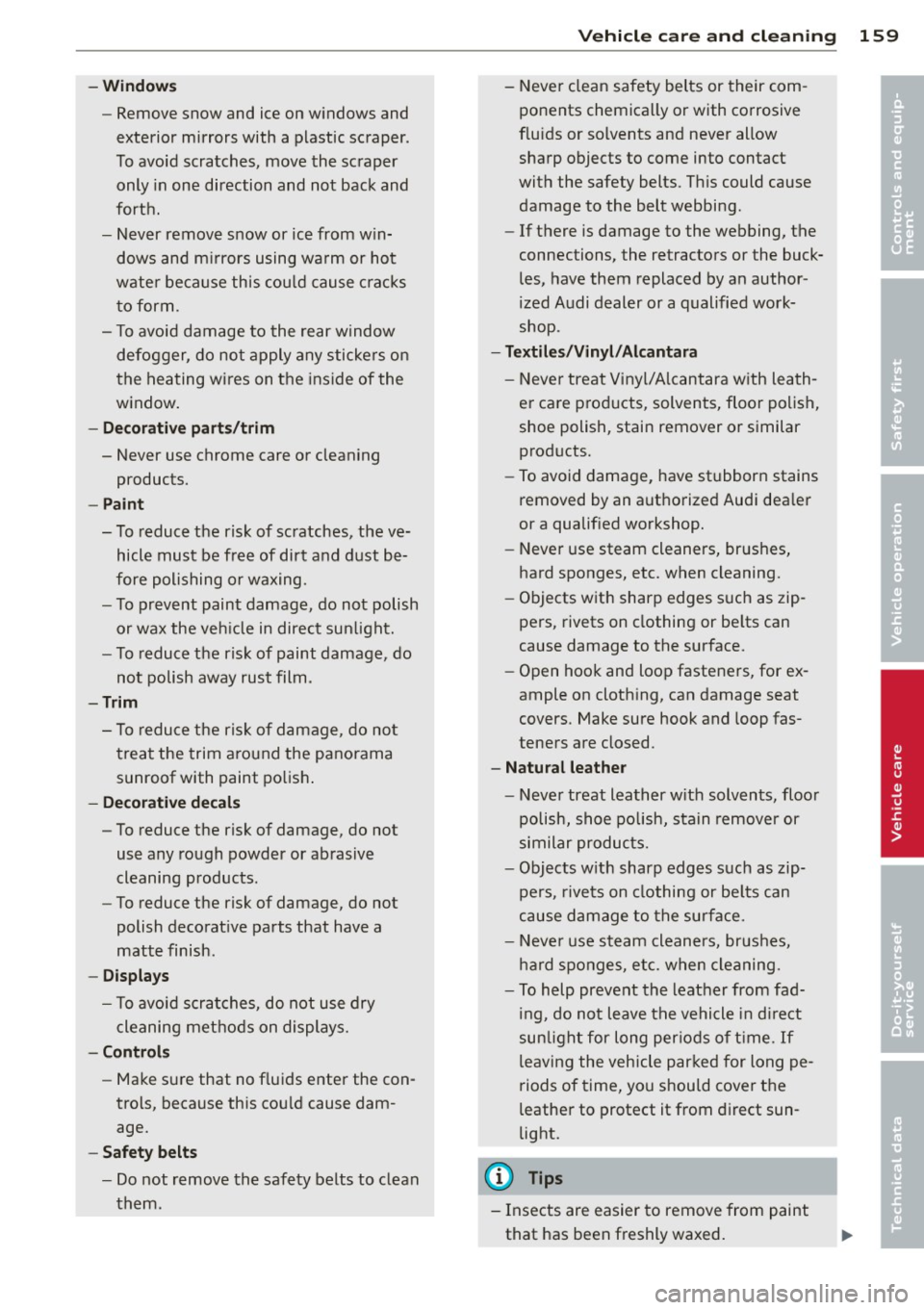
-Window s
-Remove snow and ice on windows and
exterior mirrors with a plastic scraper .
To avoid scratches, move the scraper only in one direction and not back and
forth.
- Never remove snow or ice from w in
dows and m irrors using wa rm or hot
wate r because this cou ld cause crac ks
t o form .
- To avoid damage to the rear window
defogger, do not apply any sticke rs on
the heating wires on the ins ide of the
window.
- Deco rative p art s/ trim
- Never use chrome care or cleaning
products.
-Pa int
- To reduce the risk of scratches, the ve-
hicle must be free of dirt and dust be
fore polishing or waxing.
- To prevent paint damage, do not polish
or wax the veh icle in direct sunlight.
- To reduce the risk of paint damage, do
not polish away rust film .
-Trim
- To reduce the risk of damage , do not
treat the trim around the panorama
sunroof with paint po lish .
-Deco rative d eca ls
- To reduce the risk of damage, do not
use any rough powder or abrasive
cleaning products.
- To reduce the risk of damage, do not
polish decorat ive parts that have a
matte finish .
-Di spla ys
- To avoid scratches, do not use dry
cleaning methods on displays.
- Control s
-Make sure that no fluids enter the con-
trols, because this cou ld cause dam
age.
- Safe ty belt s
-Do not remove the safety belts to clean
them.
V ehicl e ca re a nd cl eanin g 159
- Neve r clean safety belts or their com
ponents chemically or with corrosive
flu ids or solvents and never allow
sharp objects to come into contact
with the safety belts . This could cause
damage to the belt webbing .
- If there is damage to the webbing, the
connections, the retractors or the buck
les, have them replaced by an author
ized Audi dealer or a qualified work
shop.
- Te xtil es/ Vin yl/ Alcantara
- Never treat Vinyl/Alcantara w ith leath-
er ca re p rod ucts, solvents, floor polish,
shoe polish, stain remover or similar products.
- To avoid damage, have stubborn stains
removed by an authorized Audi dea ler
o r a qualified workshop.
- Never use steam cleaners, brushes,
hard sponges, etc. when cleaning.
- Objects with sharp edges such as zip
pers, rivets on clothing or be lts can
cause damage to the surface.
- Open hook and loop fasteners, for ex
ample on clothing, can damage seat
covers. Make sure hook and loop fas
teners are closed .
-Natural leather
- Never treat leather w ith solvents, floo r
polish, shoe polish, stain remover or
similar products.
- Objects w ith sharp edges such as zip
pers, rivets on clothing or be lts can
cause damage to the surface.
- Never use steam cleaners, brushes,
hard sponges, etc. when cleaning.
- To help prevent the leather from fad
ing , do not leave the vehicle in d irect
sun light for long per iods of t ime .
If
leaving the vehicle par ked for long pe
riods of time, you should cover the
leather to protect it from d irect sun
light.
(D Tips
- Insects are easier to remove from paint
that has been freshly waxed.
•
•
Page 162 of 244

160 Vehicle care and cleaning
- Regu lar wax ing can prevent rust f ilm
from forming.
- Decorative par ts can go through an
agent process, for example by becoming brittle, due to various environmenta l
cond itions. The intens ity o f their co lor
may c hange if exposed to excessive sun
li ght .
Page 163 of 244
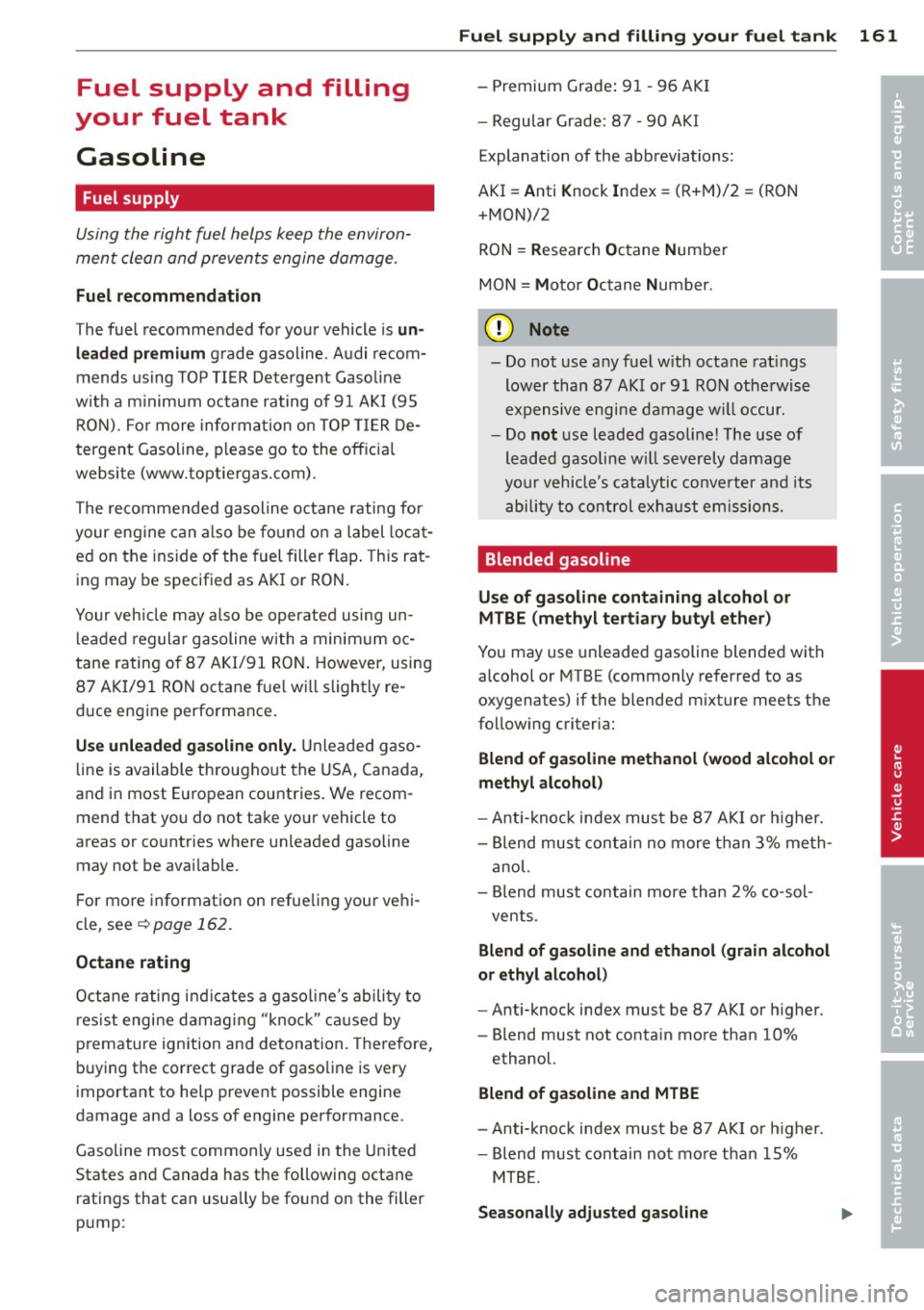
Fuel supply and filling
your f uel tank
Gasoline
Fuel supply
Using the right fuel helps keep the environ
ment clean and prevents engine damage.
Fuel recommendation
The fuel recommended for you r vehicle is un
leaded premium
g rade gasolin e. A udi recom
mends us ing TO P TI ER D etergent Gaso line
w ith a m inim um octane ra ting of 91 A KI ( 95
RON ). Fo r more inform ation on TOP TIER De
tergent Gasoline, please go to the off ic ial
website (www.toptie rgas .com) .
The re commended gasoline octane rating for
your en gine can also be fo und o n a label loca t
ed on t he ins ide of the fuel filler flap . This ra t
ing may be specif ied as AKI or RO N.
Your veh icle may al so be operated using un
l e aded regular g asoline w ith a min imum o c
tane rating of 87 AK I/91 RO N. However, using
87 AK I/91 RON octa ne fue l w ill sli ghtly re
d uce eng ine perfo rmance .
Use unleaded ga solin e only. Unleaded g aso
line is available th rougho ut the USA, Ca nada,
and i n most E uropean countries . We recom
mend that you do not ta ke yo ur vehicle to
areas or co untries where unleaded gasoline
may not be ava ilable.
F or mo re informat ion on refue ling your ve hi
cle, see
~ page 162.
Octane rating
Octane rati ng in dicates a gaso line's abili ty to
r es is t engi ne da mag in g "knoc k" ca use d b y
p remature ign ition and detona tion. Therefore,
b uying the correct grade of gaso line is very
i mportant to he lp prevent possible engine
damage and a loss o f engine performance.
Gasoline mos t common ly used in the Unite d
States an d Canada has the following octane
ratings that ca n usua lly be fo und on the filler
pump:
Fuel supply and filling your fuel tank 161
- Premium Grade: 9 1 -96 AKI
- Regular Grade: 87 -90 AKI
Explanation of the abb reviations :
AKI = Anti Knock Index = (R+ M)/2 = (RO N
+M ON)/2
RON = Research Octane Num ber
M ON = M otor Octane Number.
@ Note
- Do not use a ny fue l w it h octane rat ings
lower than 87 A KI or 9 1 RO N oth erwise
ex pensive engi ne da mage w ill occu r.
- Do
not use leaded gasoli ne! The use of
leade d gasoline w ill severely damage
yo ur vehicle's cata ly tic co nve rter and i ts
a bili ty to con trol exh aust emi ssion s.
Blended gasoline
Use of gasoline containing alcohol or
MTBE (methyl tertiary butyl ether )
You may use unleaded gasoline blende d with
alcohol or MTBE (commonly referred to as
oxygenates) if the blended m ixture meets the
fo llow ing criter ia:
Blend of gasoline methanol (wood alcohol or
methyl alcohol )
-Anti -kno ck index mus t be 87 A KI or higher.
- Blend mus t contain no more t han 3% me th-
a nol.
- Blend must contain more than 2% co-sol-
vents.
Blend of gasoline and ethanol (grain alcohol
or ethyl alcohol)
- Anti-knock index must be 87 AKI or higher.
- Blend must not conta in more than 10%
ethanol.
Blend of gasoline and MTBE
- Anti -kno ck index mus t be 87 A KI or higher.
- Blend must contain no t mo re tha n 15%
MTB E.
Seasonally adjusted gasoline
•
•
Page 164 of 244
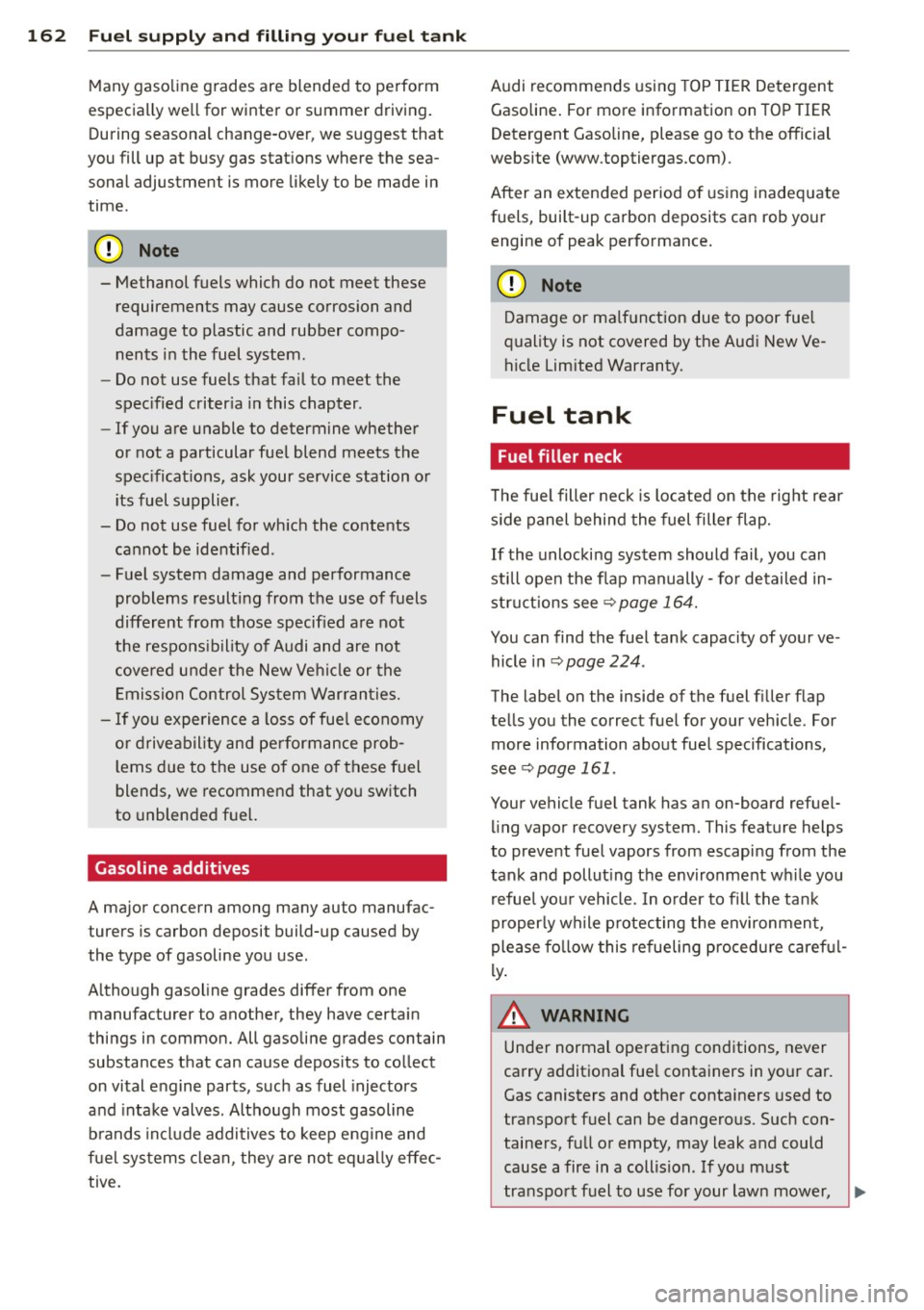
162 Fuel supply and filling your fuel tank
Many gasoline grades are blended to perform
especially well for winter or summer driving.
During seasonal change-over, we suggest that
you fill up at busy gas stations where the sea sonal adjustment is more likely to be made in
time.
@ Note
- Methanol fuels which do not meet these
requirements may cause corrosion and
damage to plastic and rubber compo
nents in the fuel system.
- Do not use fuels that fail to meet the
specified criteria in this chapter .
- If you are unable to determine whether
or not a particular fuel blend meets the
specifications, ask your service station or i ts fuel supplier .
- Do not use fuel for which the contents
cannot be identified .
- Fuel system damage and performance
problems resulting from the use of fuels
different from those specified are not
the responsibility of Audi and are not
covered under the New Vehicle or the
Emission Control System Warranties.
- If you experience a loss of fue l economy
or driveability and performance prob
lems due to the use of one of these fuel
blends, we recommend that you switch
to unblended fuel.
Gasoline additives
A major concern among many auto manufac
turers is carbon deposit build-up caused by
the type of gasoline you use .
Although gasoline grades diffe r from one
manufac turer to another, they have certain
things in common. All gasoline grades contain
substances that can cause deposits to collect
on vital engine parts, such as fuel injectors
and intake valves. Although most gasoline
brands include additives to keep engine and
fuel systems clean, they are not equally effec
tive. Audi recommends
using TOP TIER Detergent
Gasoline . For more information on TOP TIER
Detergent Gasoline, please go to the official
website (www.toptiergas .com) .
After an extended period of using inadequate
fuels, built-up carbon deposits can rob your engine of peak performance.
(D Note
Damage or malfunction due to poor fuel
quality is not covered by the Audi New Ve
hicle Limited Warranty.
Fuel tank
Fuel filler neck
The fuel filler neck is located on the right rear
side panel behind the fuel filler flap.
If the unlocking system should fail, you can
still open the flap manually -for detailed in
structions see
~ page 164.
You can find the fuel tank capacity of your ve
hicle in~
page 224 .
The label on the inside of the fuel filler flap
tells you the correct fuel for your vehicle. For
more information about fuel specifications,
see
~ page 161 .
Your vehicle fuel tank has an on-board refuel
ling vapor recovery system. This feature helps
to prevent fuel vapors from escaping from the
tank and polluting the environment while you refuel your vehicle. In order to fill the tank
properly while protecting the environment,
please follow this refueling procedure careful
ly.
.&_ WARNING ~
Under normal operating conditions, never
carry additional fuel containers in your car.
Gas canisters and other containers used to
transport fuel can be dangerous. Such con
tainers, full or empty, may leak and could
cause a fire in a collision . If you must
transport fuel to use for your lawn mower, ..,.
Page 165 of 244
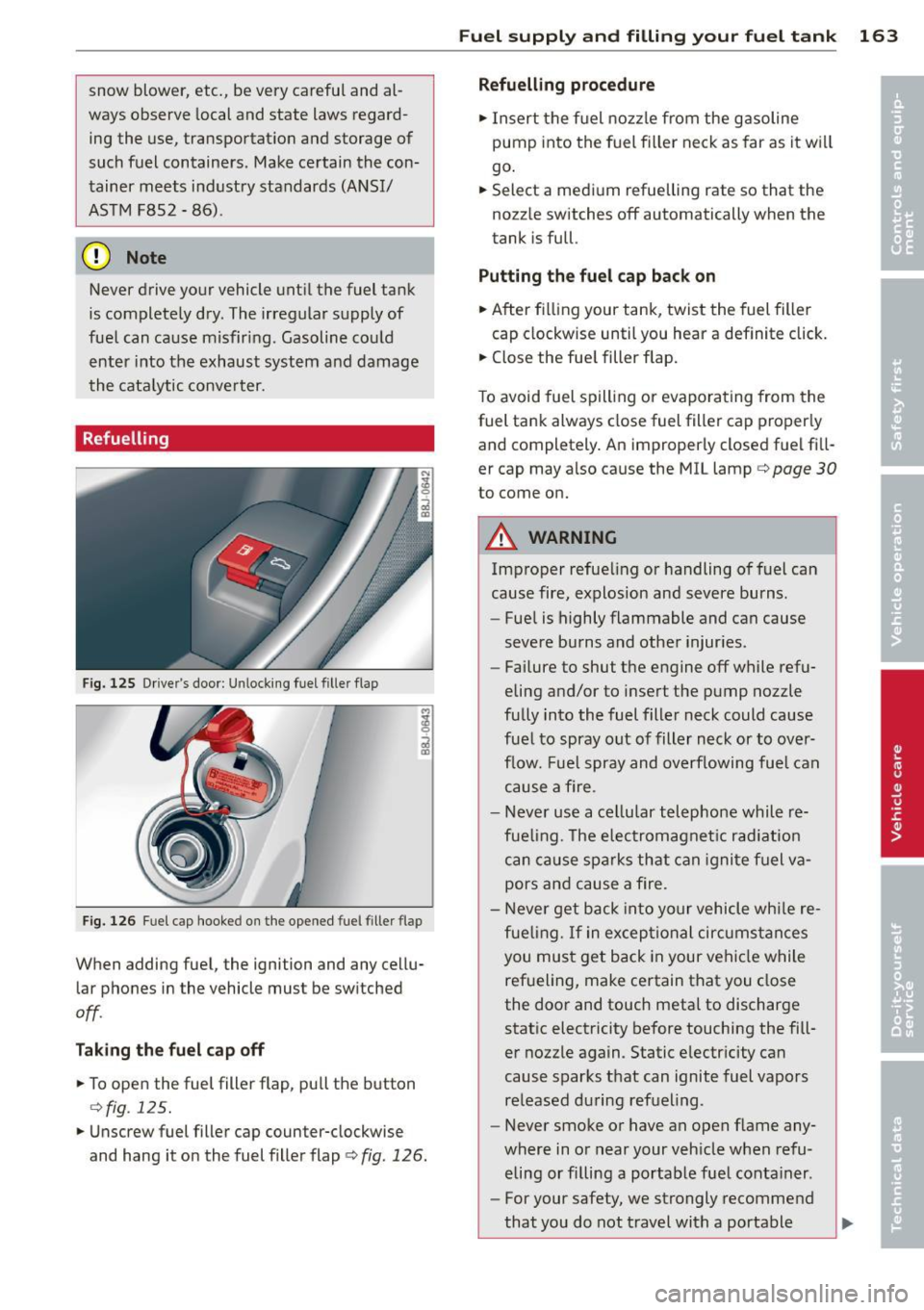
snow blower, etc., be very careful and al
ways observe local and state laws regard
ing the use, transportat ion and storage of
such fuel containers. Make certain the con t ainer meets industry standards (ANSI/
AS TM F8S2 -86).
(D Note
Never drive your vehicle unti l the fuel tank
is completely dry. The irregular supply of
fue l can cause misfir ing. Gasoline cou ld
enter into the exhaust system and damage
the cata lytic conve rter.
Refuelling
F ig. 125 D river's door: Un locki ng fuel filler flap
Fig. 1 26 Fuel cap hooked o n the opened fuel fi ller flap
When adding fuel, the ignition and any cellu
lar phones in the vehicle must be switched
off.
Taking the fuel cap off
.,. To open the fuel filler flap, pull the button
¢fig. 125.
.,. Unscrew fuel filler cap counter-clockwise
and hang it on the fuel filler flap ¢
fig. 126.
Fuel supply and filling your fuel t ank 163
Refuelling procedure
.,. Insert the fuel nozzle from the g asoline
pump into the fuel fi ller neck as far as it wi ll
go .
.,. Select a med ium refuelling rate so that the
nozz le switches off automatically when the
tank is full.
Putting the fuel cap bac k on
.,. After fi lling your tank, twist the fuel filler
cap clockwise until you hear a definite click.
.,. Close the fue l filler flap.
T o avoid fuel spill ing or evaporating from the
fuel tank always close fuel filler cap proper ly
and completely. An improperly closed fuel fill
er cap may also cause the MIL lamp¢
page 30
to come on.
A WARNING
Improper refue ling or handling of fuel can
cause fire, explosion and severe burns.
- Fue l is highly flammable and can cause
severe burns and other injur ies.
- Failure to shut the engine off while refu
eling and/or to insert the pump nozzle
fully into the fuel filler neck could cause
fue l to spray o ut of filler neck or to over
flow. Fue l spray and overflowing fuel can
cause a fire.
- Never use a ce llu lar telephone while re
fue ling. The electromagnet ic rad iat ion
can cause sp arks that can ignite fuel va
pors and cause a fire.
- Never get back into yo ur vehicle while re
fue ling.
If in excep tional circumstances
you must get back in your vehicle while ref ueling, make certain that you close
the door and touch metal to discharge
static electricity before touching the fill
er nozzle again. Static electr icity can
cause sparks that can ignite fuel vapors
released during refue ling.
- Never smoke or have an open flame any
where in or near your veh icle when refu
eling or filling a portab le fuel conta iner.
- For your safety, we strongly recommend
that you do not t ravel with a portable
Page 166 of 244
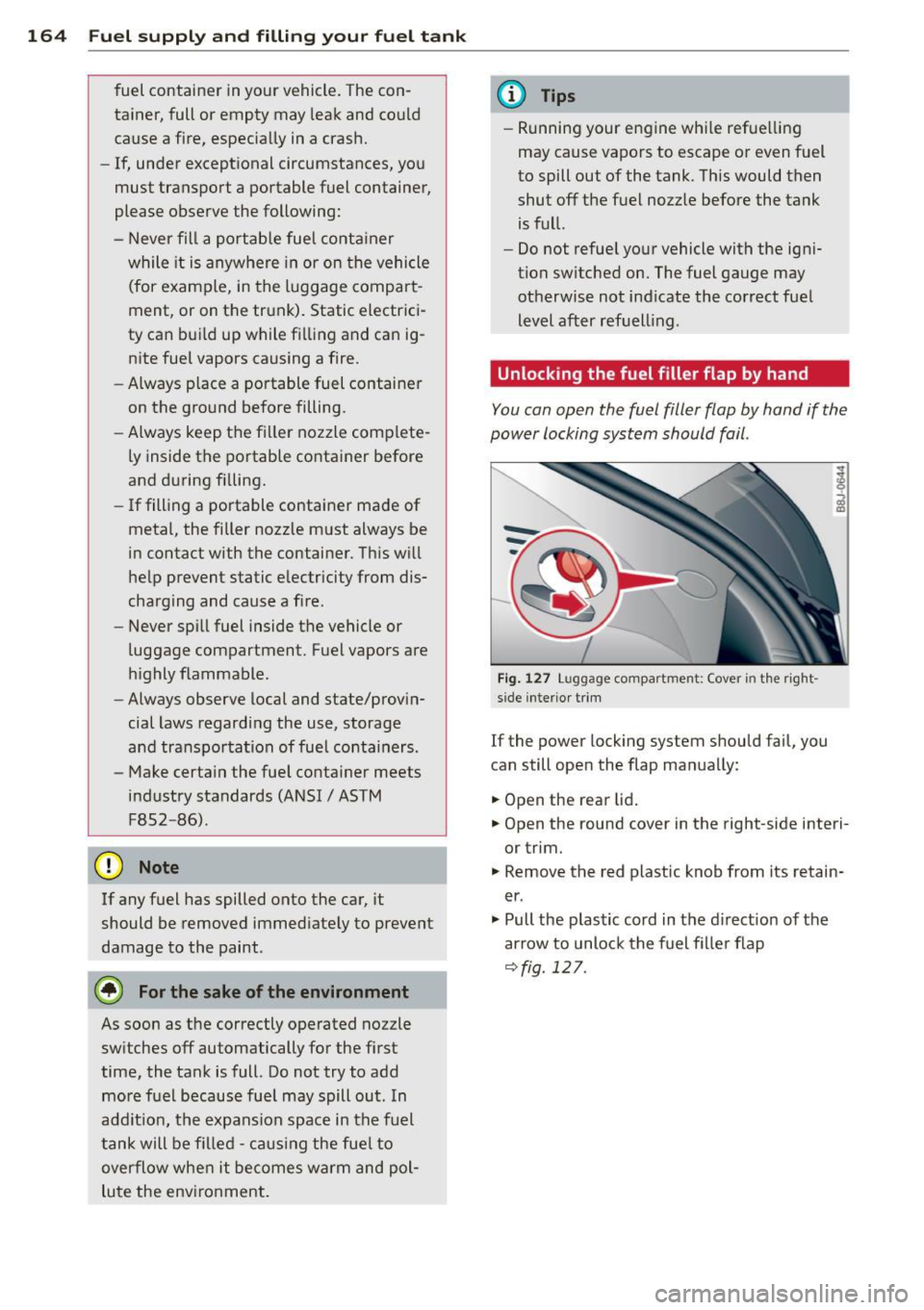
164 Fuel suppl y and filli ng your fuel t ank
fuel container in your vehicle . The con
tainer, full or empty may leak and could
cause a fire, especially in a crash.
- If, under exceptional circumstances, you
must transport a portable fuel container,
please observe the following:
- Never fill a po rtable fuel conta iner
while it is anywhere in or on the vehicle
(for example, in the luggage compart
ment, or on the tr unk). Static electrici
ty can bui ld up while filling and can ig
n ite fuel vapors causing a fire .
- Always place a po rtable fuel container
on the ground before filling.
- Always keep the f iller nozzle complete
l y inside the portable container before
and d uring fi lling.
- If filling a portable container made of
metal, the filler nozz le must always be
in contact with the container. Th is w ill
he lp prevent static electricity from dis
charging and cause a fi re .
- Never sp ill fuel inside the vehicle or
luggage compartment. Fuel vapors are
h ighly flammable.
- Always observe local and state/provi n
cial laws regarding the use, storage
and transporta tion of fuel conta iners.
- Make certain the fuel container meets
industry standards (ANSI/ ASTM
F8S2 -86) .
d) Note
If any fuel has spilled onto the car, it
should be removed immediate ly to prevent
damage to the paint .
@ For the sake of the environment
As soon as the correctly operated nozzle
switches off automatically for the first
time, the tank is full. Do not try to add more fue l because fuel may spill out. In
add it ion, the expans ion space in the fuel
tank will be fi lled -causing the fue l to
overflow whe n it becomes warm and pol
lute the env ironment.
(D Tips
- Running your engine whi le refue lling
may cause vapors to escape or even fuel
to spill out of the tank. This would then
shut off the fuel nozz le before the tank
is full.
- Do not refuel your vehicle with the igni
tion switched on. The fuel gauge may otherwise not ind icate the correct fue l
level after ref uelling .
Unlocking the fuel filler flap
by hand
You can open the fuel filler flap by hand if the
power locking system should fail.
F ig . 12 7 Luggage compartment: Cover in the rig ht
side interio r trim
If the power locking system should fail, you
can still ope n the flap ma nually:
.. Open the rear lid .
.. Open the round cover in the right-side interi
or trim.
.. Remove the red plastic knob from its retain
er .
.. Pull the p lastic cord in the d irect ion of the
arrow to unlock the fuel fi ller flap
qfig. 127.
Page 167 of 244
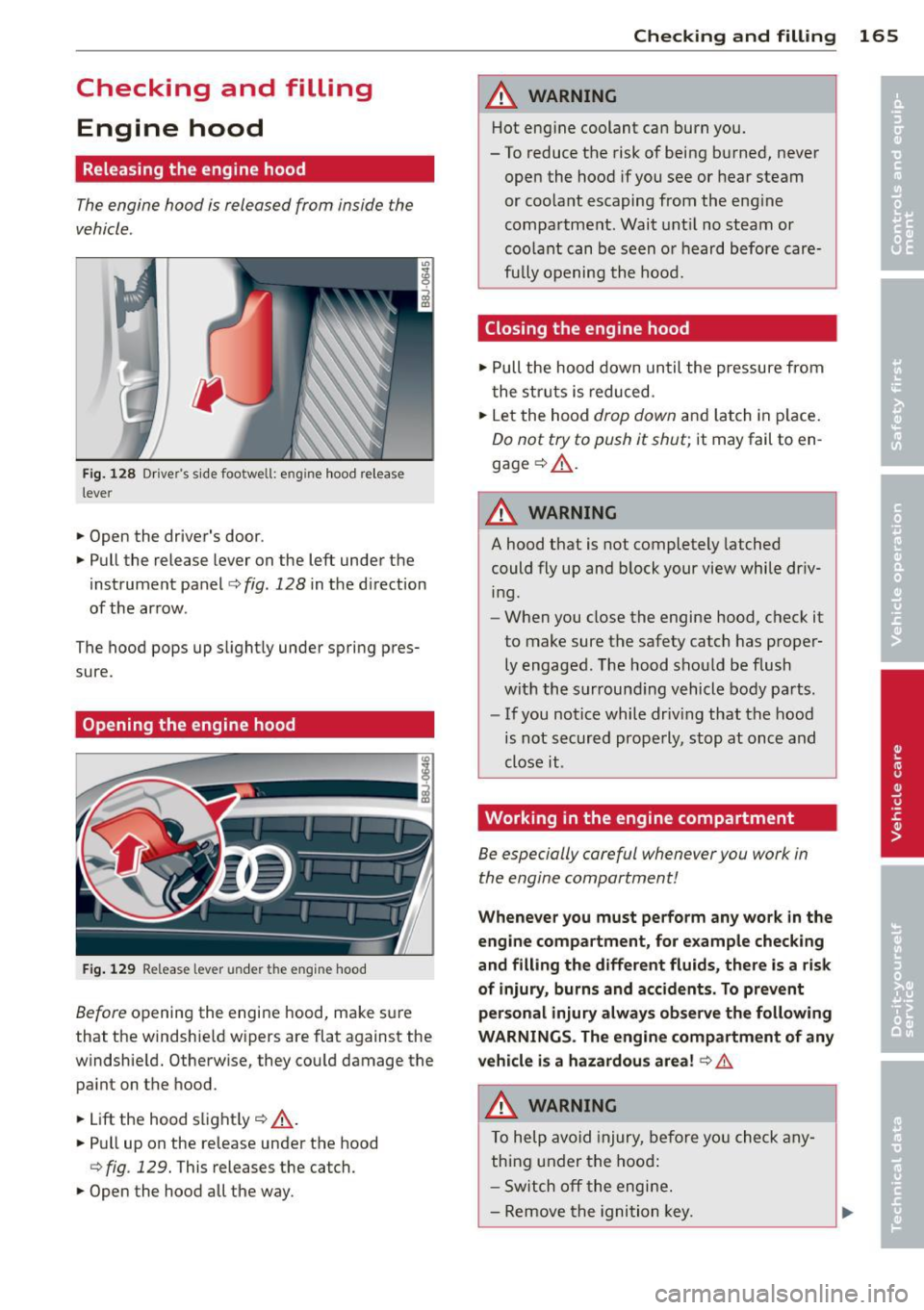
Checking and filling Engine hood
Releasing the engine hood
The engine hood is released from inside the
vehicle .
Fig. 128 Dr ive r's s ide footwe ll: e ng ine hood relea se
lever
"' Open the driver's door .
"' Pull the release lever on the left under the
instrument panel
i=> fig. 128 in the d irection
of the arrow .
The hood pops up slightly under spring pres
sure.
Opening the engine hood
F ig . 129 Release lever u nde r the engine hood
Before opening the engi ne hood, make sure
that the windshield wipers are flat against the
windshie ld. Otherwise, they could damage the
paint on the hood.
"' Lift the hood slight ly ¢
_A .
"' Pull up on the release under the hood
¢ fig . 129. This releases the catch.
"' Open the hood all the way .
Checking and fillin g 165
A WARNING
Hot engine coolant can burn you.
- To reduce the risk of being burned, never open the hood if you see or hear steam
or coolant escaping from the eng ine
compartment . Wait unt il no steam or
coolant can be seen or heard before care
fu lly opening the hood.
Closing the engine hood
"' Pull the hood down until the pressure from
the struts is reduced.
"' Let the hood
drop down and latch in p lace.
Do not try to push it shut; it may fail to en
gage ¢_& .
A WARNING
--
A hood that is not completely latched
could fly up and b lock your view while dr iv
ing.
- When you close the engine hood, check it
to make sure the safety catch has proper
ly engaged. The hood shou ld be flush
with the surround ing vehicle body parts.
- If you notice while driv ing that the hood
is not secured properly, stop at once and
close it .
Working in the engine compartment
Be especially careful whenever you work in
the engine compartment!
Whenever yo u must pe rform any wo rk in the
e n g ine compartment, for e xample ch ecki ng
and filling th e diff erent fluids, there is a risk
of injury, burn s and a ccidents. To prev ent
p ersonal injury always obse rve the foll owing
WARNINGS . The engine compa rtment of an y
vehicle i s a hazardou s area !
¢ &.
A WARNING ~
To help avoid injury, be fo re yo u check any
thing under the hood:
- Sw itch off the engi ne.
- Remove the ignition key.
Page 168 of 244
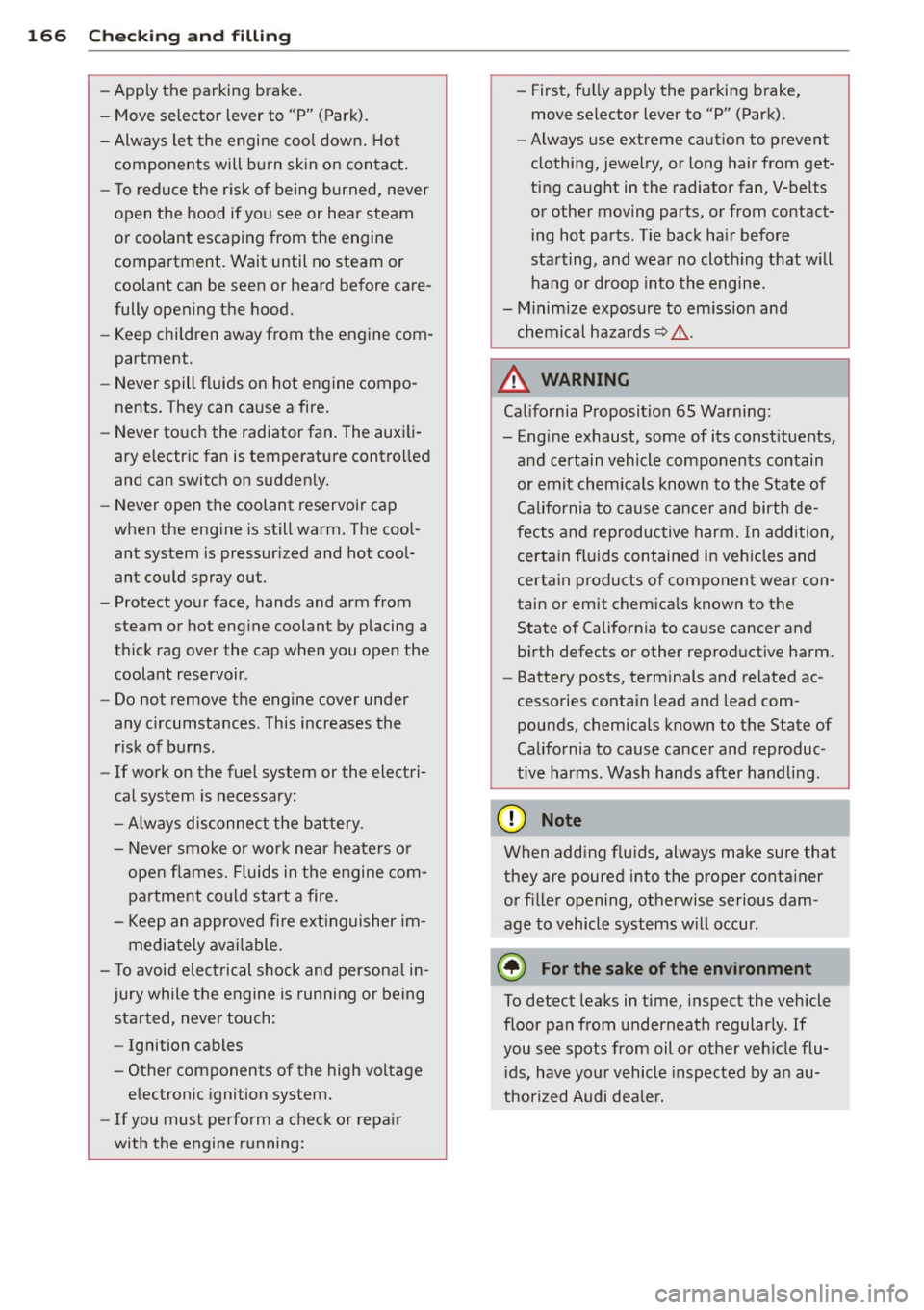
166 Checking and filling
-Apply the parking brake.
- Move selector lever to "P" (Park).
- Always let the engine cool down. Hot
components will burn skin on contact.
- To reduce the risk of being burned, never
open the hood if you see or hear steam
or coolant escaping from the engine
compartment . Wait until no steam or
coolant can be seen or heard before care
fully opening the hood.
- Keep children away from the engine com
partment .
- Never spill fluids on hot engine compo
nents. They can cause a fire.
- Never touch the radiator fan. The auxili
ary electric fan is temperature controlled
and can switch on suddenly.
- Never open the coolant reservoir cap
when the engine is still warm. The cool
ant system is pressurized and hot cool
ant could spray out .
- Protect your face, hands and arm from
steam or hot engine coolant by placing a
thick rag over the cap when you open the coolant reservoir .
- Do not remove the engine cover under
any circumstances . This increases the
risk of burns.
- If work on the fuel system or the electri
cal system is necessary:
- Always disconnect the battery .
- Never smoke or work near heaters or
open flames. Fluids in the engine com
partment could start a fire.
- Keep an approved fire extinguisher im
mediately available.
- To avoid electrical shock and personal in
jury while the engine is running or being
started, never touch:
- Ignition cables
- Other components of the high voltage
electronic ignition system.
- If you must perform a check or repair
with the engine running: -
First, fully apply the parking brake,
move selector lever to "P" (Park) .
- Always use extreme caution to prevent
clothing, jewelry, or long hair from get
ting caught in the radiator fan, V-belts
or other moving parts, or from contact ing hot parts. Tie back hair before
starting, and wear no clothing that will hang or droop into the engine.
- Minimize exposure to emission and chemical hazards~&, .
A WARNING
=
California Proposition 65 Warning:
- Engine exhaust, some of its constituents, and certain vehicle components contain
or emit chemicals known to the State of
California to cause cancer and birth de
fects and reproductive harm. In addition,
certain fluids contained in vehicles and
certain products of component wear con
tain or emit chemicals known to the
State of California to cause cancer and
birth defects or other reproductive harm.
- Battery posts, terminals and related ac
cessories contain lead and lead com
pounds, chemicals known to the State of
California to cause cancer and reproduc
tive harms. Wash hands after handling.
(D Note
When adding fluids, always make sure that
they are poured into the proper container
or filler opening, otherwise serious dam
age to vehicle systems will occur.
@) For the sake of the environment
To detect leaks in time, inspect the vehicle
floor pan from underneath regularly. If
you see spots from oil or other vehicle flu ids, have your vehicle inspected by an au
thorized Audi dealer.
Page 169 of 244
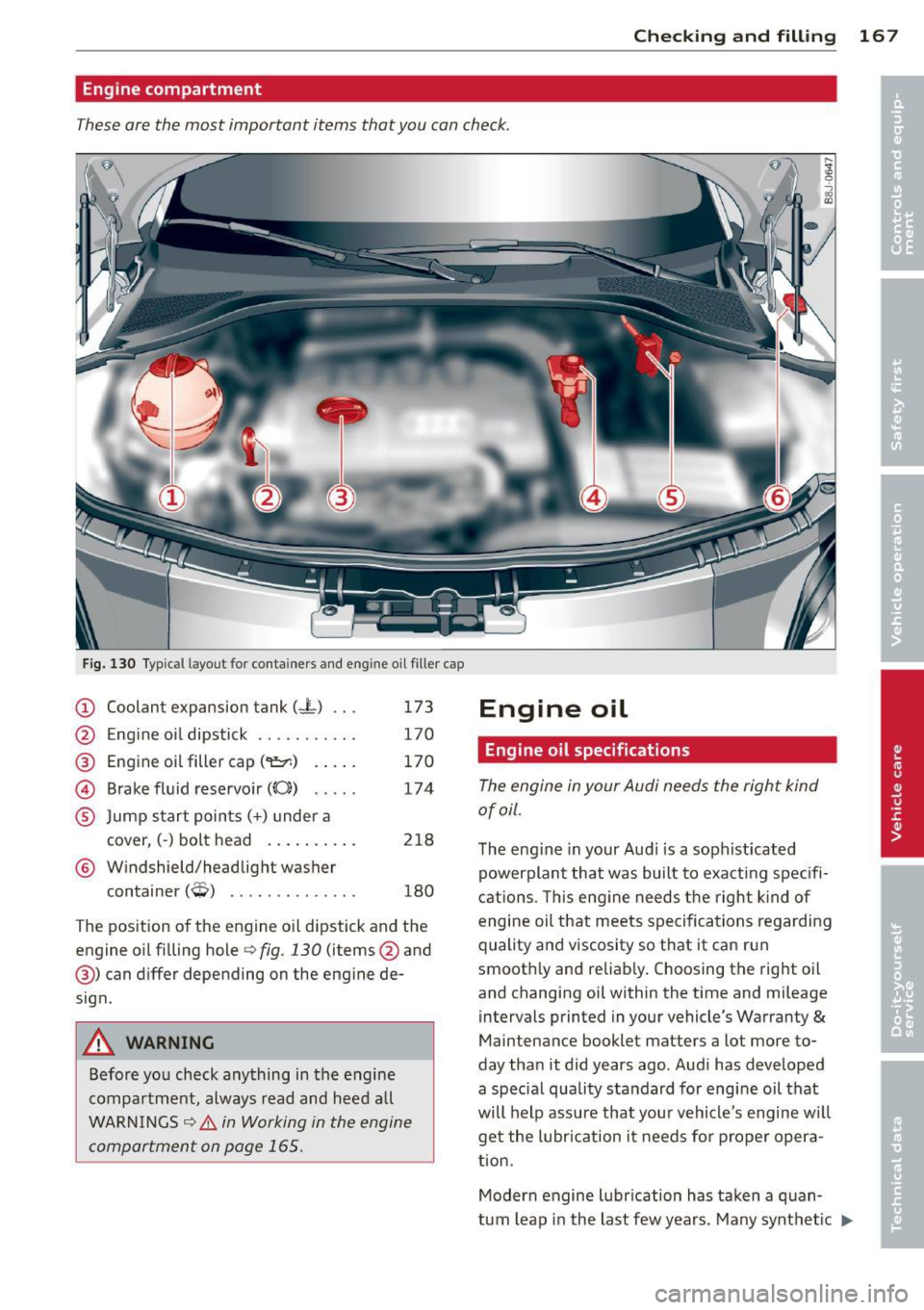
Checking and fillin g 167
Eng ine compartment
These are the most important items that you can check .
•
Fig. 130 Typ ical layout for containers and eng ine oil filler cap
(D Coolant expansion tank (-L) . . . 173
@ Eng ine oi l dipstick . . . . . . . . . . . 170
@ Engine oil filler cap (
® Jump start points(+) under a
cover,(-) bolt head . . . . . . . . . . 218
® Windshield/headlight washer
t . (ffi) con amer *
...... ....... . 180
The position of the engine o il dipstick and the
engine oil filling hole
i::> fig. 130 (items @and
@) can differ depending on the engine de
sign.
_&. WARNING
Before yo u check anything in the engine
compartment, always read and heed all
WARN INGS
i::> &. in Working in the engine
compartment on page 165.
Engine oil
Engine oil specifications
The engine in your Audi needs the right kind
of oil.
The eng ine in your Aud i is a sophist icated
powerplant that was built to exacti ng spec ifi
cations . T his eng ine needs t he right k ind of
engine oil that meets specifications regarding
quality and viscosity so that it can run
smoot hly and reliably . Choosing the right o il
and changing oil within the time and mileage
intervals printed in your vehicle's Warranty
&
Maintenance booklet matters a lot more to
day than it did years ago. Audi has developed
a specia l quality standard for engine oil t hat
will help assu re that you r vehicle's engine w ill
get the l ubr ication i t needs fo r proper opera
tion.
Modern engine lubr ication has taken a q uan
tum leap in the last few years. Many synt het ic
IJI,,
Page 170 of 244
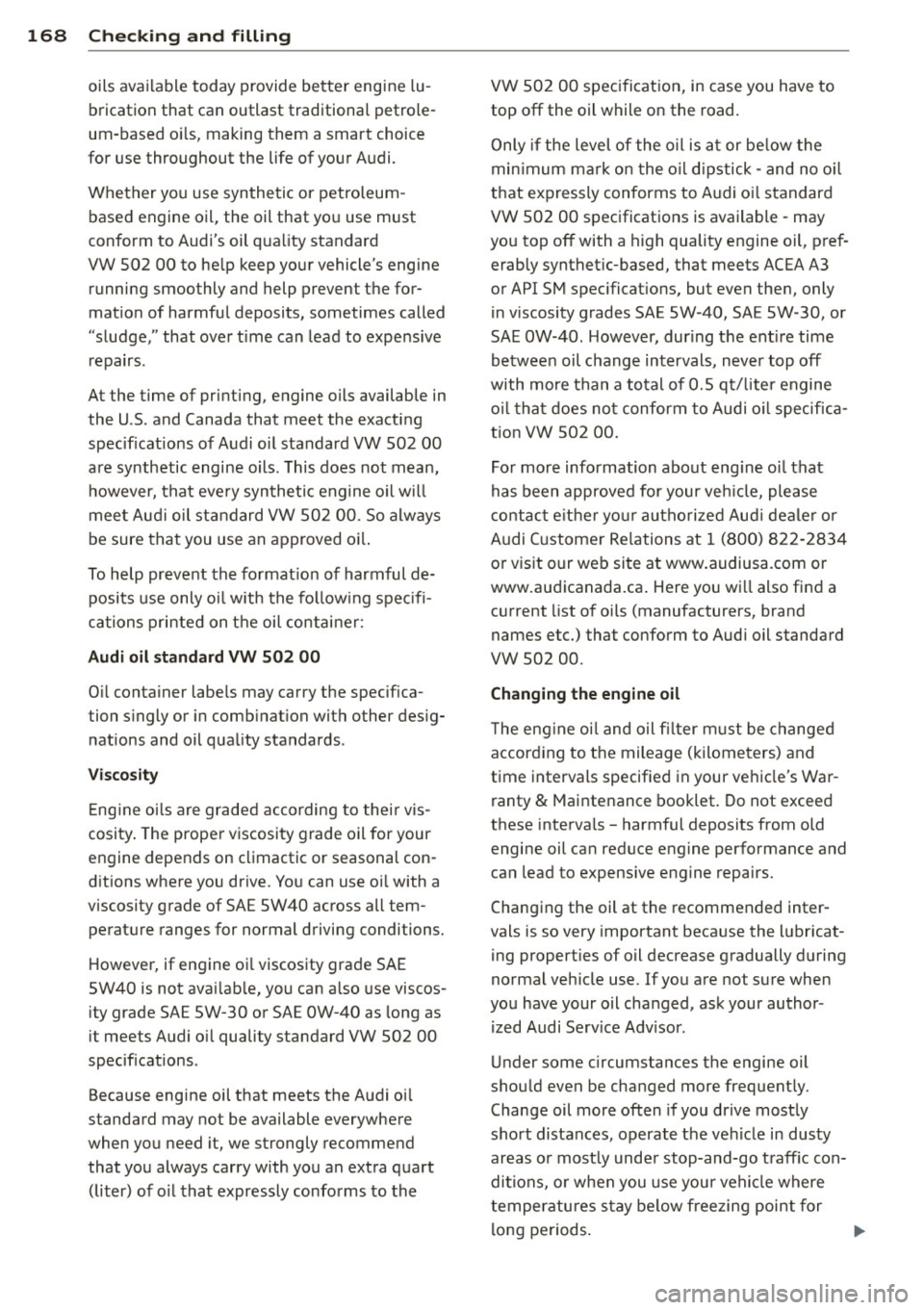
168 Checking and filling
oils available today provide better engine lu
brication that can outlast traditional petrole
um-based oils, making them a smart choice
for use throughout the life of your Audi.
Whether you use synthetic or petroleum
based engine oil, the oil that you use must
conform to Audi's oil quality standard
VW 502 00 to help keep your vehicle's engine
running smoothly and help prevent the for
mation of harmful deposits, sometimes called
"sludge," that over t ime can lead to expensive
repairs .
At the time of printing, engine oils available in
the U .S . and Canada that meet the exacting
specifications of Audi oil standard VW 502 00
are synthetic engine oils. This does not mean, however, that every synthetic engine oil will
meet Audi oil standard VW 502 00. So always
be sure that you use an approved oil.
To help prevent the formation of harmful de posits use only oil with the following specifi
cations printed on the oil container:
Audi oil standard VW 502 00
Oil container labels may carry the specifica
tion singly or in combination with other desig
nations and oil quality standards .
Viscosity
Engine oils are graded according to their vis
cosity. The proper viscosity grade oil for your
engine depends on climactic or seasonal con
ditions where you drive. You can use oil with a
viscosity grade of SAE 5W40 across all tem
perature ranges for normal driving conditions.
However, if engine oil viscosity grade SAE
5W40 is not available, you can also use viscos
ity grade SAE 5W-30 or SAE OW-40 as long as
it meets Audi oil quality standard VW 502 00
specifications .
Because engine oil that meets the Audi oil
standard may not be available everywhere
when you need it, we strongly recommend
that you always carry with you an extra quart (liter) of oil that expressly conforms to the VW 502 00 specification, in case you have to
top
off the oil while on the road.
Only if the level of the oil is at or below the
minimum mark on the oil dipstick - and no oi l
that expressly conforms to Audi oil standard
VW 502 00 specifications is available -may
you top
off with a high quality engine oil, pref
erably synthetic-based, that meets ACEA A3
or API SM specifications, but even then, only
in viscosity grades SAE SW-40, SAE 5W-30, or
SAE OW-40 . However, during the entire time
between oil change intervals, never top
off
with more than a total of 0.5 qt/liter engine
oil that does not conform to Audi oil specifica
tion VW 502 00.
For more information about engine oil that
has been approved for your vehicle, please
contact either your authorized Audi dealer o r
Audi Customer Relations at 1 (800) 822-2834
or visit our web site at www.audiusa.com or
www.audicanada.ca . Here you will also find a
current list of oils (manufacturers, brand
names etc.) that conform to Audi oil standard
vw 502 00.
Changing the engine oil
The engine oil and oil filter must be changed
according to the mileage (kilometers) and
time intervals specified in your vehicle's War
ranty
& Maintenance booklet. Do not exceed
these intervals -harmful deposits from old
engine oil can reduce engine performance and
can lead to expensive engine repairs.
Changing the oil at the recommended inter
vals is so very important because the lubricat
ing properties of oil decrease gradually during
normal vehicle use. If you are not sure when
you have your oil changed, ask your author
ized Audi Service Advisor.
Under some circumstances the engine oil
should even be changed more frequently. Change oil more often if you drive mostly
short distances, operate the vehicle in dusty
areas or mostly under stop-and-go traffic con
ditions, or when you use your vehicle where
temperatures stay below freezing point for
long periods.